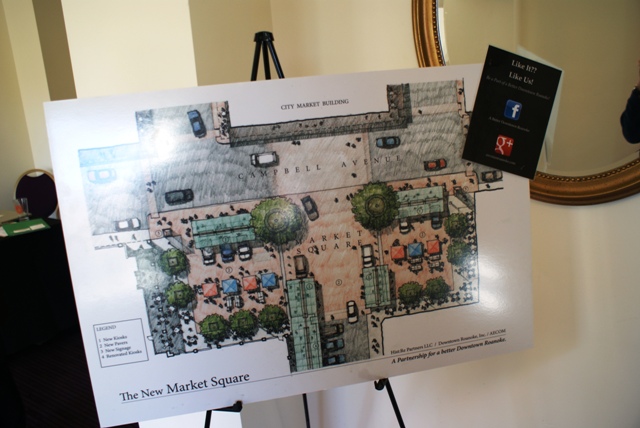
For a second straight year, developer Ed Walker and his CityWorks philanthropical organization brought together several dozen movers and shakers – people with big ideas on how to make smaller cities thrive – for the CityWorks (X)Po.
Headquartered in downtown Roanoke at the Market Building’s Charter Hall, the (X)Po also featured hardhat tours of the Center in the Square renovation project across the street, a big party after-hours on Kirk Avenue featuring a blind unicyclist stunt, and a closing beer bash at the Go Outside Festival, which took place at River’s Edge.
Eddie Amos, from the Roanoke-Blacksburg Technology Council, estimated that about 40 percent of the attendees for this year’s three-day program came from outside the region – interested perhaps in what the speakers could tell them about revitalizing their own smaller city or town.
Keynote speaker Kennedy Smith, also a participant last year, is an expert on downtown economics and the impact of sprawl. Toni Blackman, a major presence in the hip-hop world, was the 2012 host and artist-in-residence. The overall theme of this year’s program was The (X)ponential Impact of Radical Trust.
Many of the speakers had a tech-heavy angle and spoke of the need for interconnectivity. There were sessions on “Tactical Urbanism,” the impact that the Virginia Tech Carilion Research Institute has had on Roanoke, one session entitled “The Importance of Impossible Dreams,” and others that also asked attendees to look beyond “the landscape of everyday.”
Neil Takemoto, co-founder of something called a “crowdsourced placemaking” firm, talked about the need to build consensus and community support for major downtown renovation projects. Takemoto’s CPSM Group is involved with four such efforts now across the country.
He brought up an image of the proposed “New Market Square” that would close off the parking lots across the street from the City Market Building to vehicular traffic, creating outdoor public gathering places. AECOM has put together a drawing for Downtown Roanoke Inc., which is pushing for the outdoor pedestrian plaza as a final piece in transforming Roanoke.
Some people in other localities have worried that turning developable real estate into pedestrian plazas takes good property off the market, but Takemoto pointed out that those public spaces often increase the value of the properties surrounding them.
People from the suburbs are often looking for “something downtown to come to,” said Takemoto. He noted that there was “a lot of support” for such a plaza in Roanoke, although some adjacent business owners worry about the loss of vehicular traffic driving by their store or restaurant.
Takemoto noted the importance of seeking ideas from the public, whether online or via good old-fashioned paper ballots, pointing to CityWorks, which has asked for proposals on what to do with a former coffee shop space it owns in Grandin Village. “People …are sharing ideas,” said Takemoto. Making sure local residents know what the vision is for a place like downtown Roanoke can lead to “a whole new level of engagement . . . suddenly everyone is working together.”
Takemoto took part in the first CityWorks (X)Po last year, when he solicited opinions for “Vision Roanoke.” Over 300 people sent him messages on what they would like to see here, with a pedestrian-only plaza emerging as “one of the most popular ideas.”
Eddie Amos, billed as a technologist, talked about how the Roanoke-Blacksburg Technology Council has been working to promote “all of the great activities [regionally].” Still, according to Amos, the Roanoke and New River Valleys could be doing a better job of letting people know what a great place this is to live, work and play. “Our region is really poised for growth,” said Amos.
One key to future growth will be the “need for involvement from people across the board,” added Amos, noting competition from cities like Chattanooga, TN, which has made easy access to broadband a key to attracting businesses. Roanoke also lacks an “innovation center,” like the Corporate Research Center in Blacksburg, which has spun off of the adjacent Virginia Tech campus to become a haven for high-tech startups. “We have the pieces here [to create something similar],” insisted Amos.
While the next two speakers after Amos – both professors at Virginia Tech – talked about using social media to connect communities,“forming a new mindset,” Tom Sanchez called it, and how digital games can attract the younger crowd, the question might be this: How do you turn new-age thinking, social media and high-tech games into jobs, a population infusion from young professionals and consensus on a vision for Roanoke?
Start with building “a sense of place,” said Peter Skorza, who heads up the Center for Interspatial Technologies at Virginia Tech. Skorza – who also let attendees know they can actually send a Tweet to the digicam at the base of the Mill Mountain Star, instructing it to take a picture and send it back – also said it was important for the local political and civic leaders to “become digitally literate,” if Roanoke is to grow.
About that blind unicycle ride? That was by artist Mark Cline, who makes those large foam sculptures, like the two oversized hands that graced Kirk Avenue during the (X)Po’s first night. “Forever this will change the way I think about Kirk Avenue,” joked Skorza about Cline’s short but successful jaunt.
The question that remained after the second CityWorks (X)Po remains – how does all of this translate into a new vision and economic growth for the valley?
by Gene Marrano
